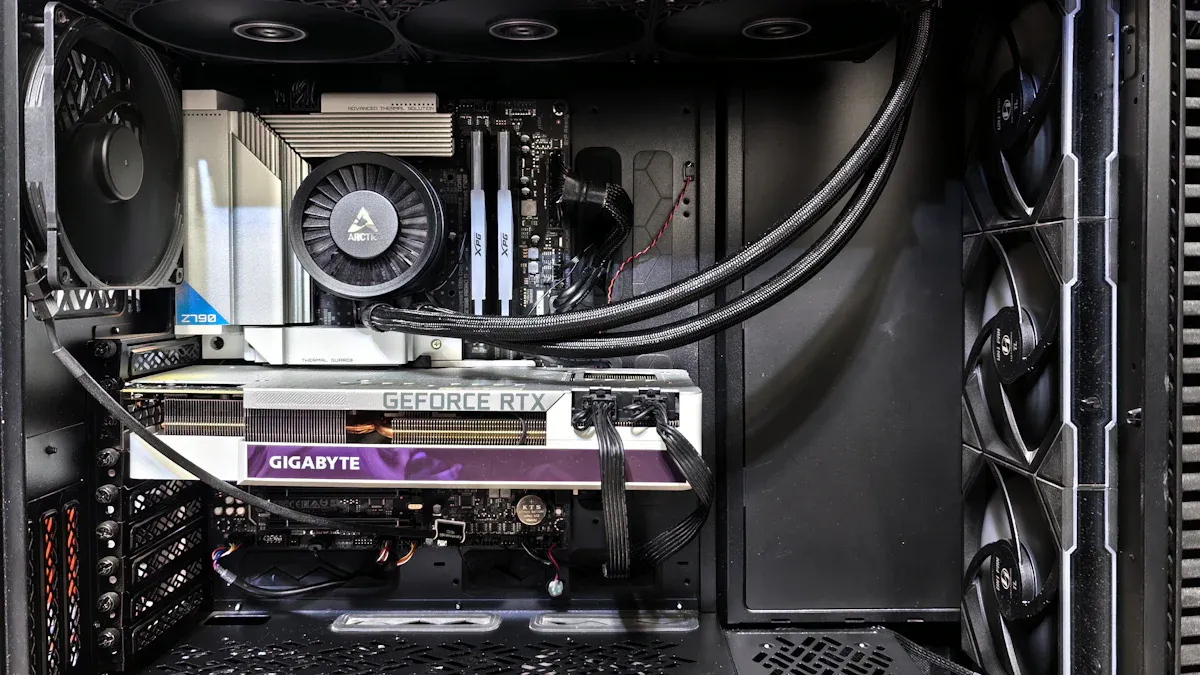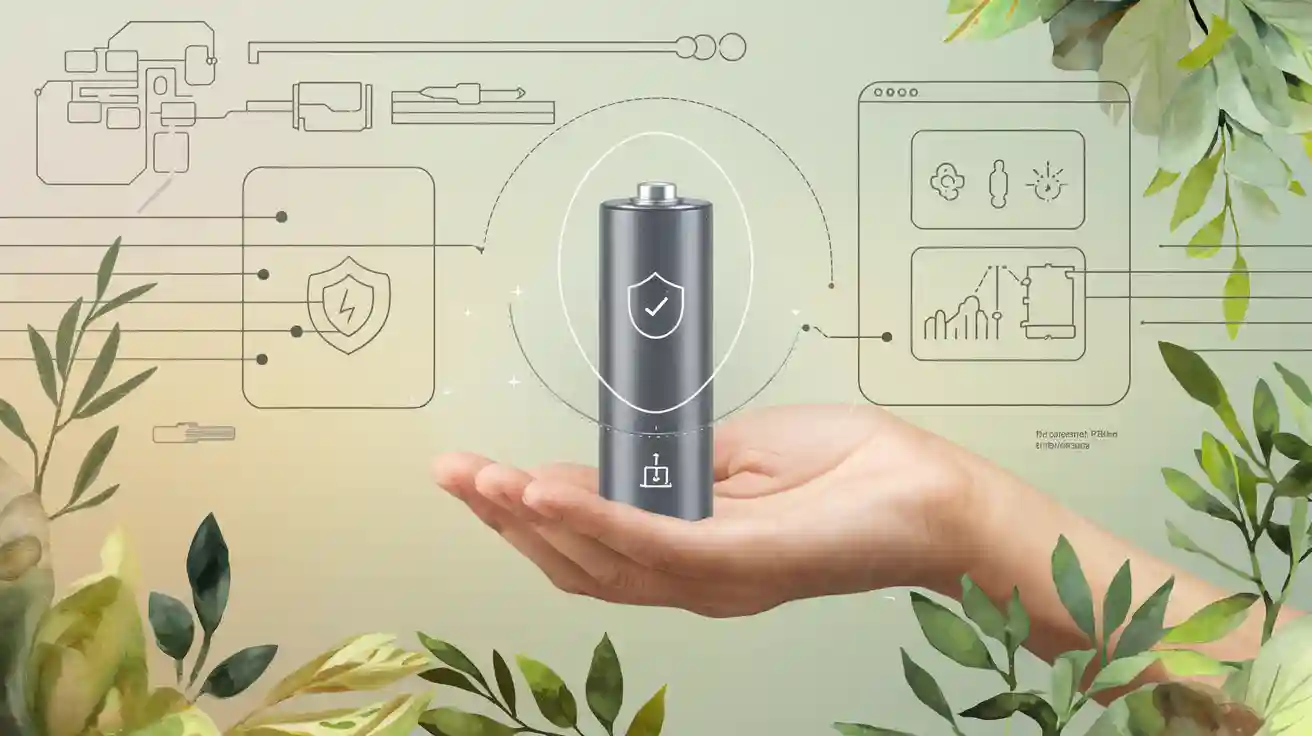How to realize the safety characteristics of Li ion batteries?
You must realize safety characteristics in li-ion batteries by combining technical strategies, strict compliance, and smart usage practices. Fires, explosions, and toxic gas leaks can occur if you ignore these safety characteristics. Large cities like New York have reported over 660 fires linked to lithium-ion batteries in six years, resulting in numerous injuries and deaths. Even a single design flaw, such as the one that caused the Samsung Galaxy Note 7 recall, can threaten safety characteristics worldwide. You need a multi-layered approach to address all safety characteristics, including chemical hazard control and fire prevention.
Key Takeaways
- Prioritize safety in lithium-ion battery design by incorporating core features like system shutdowns and early warning systems to prevent catastrophic failures.
- Implement effective thermal management techniques, such as air and liquid cooling, to control battery temperature and reduce the risk of thermal runaway.
- Follow strict charging and storage practices, including using appropriate chargers and maintaining optimal temperature, to extend battery life and enhance safety.
- Utilize advanced protection devices like over-current and over-voltage protection to mitigate risks during battery operation and prevent overheating.
- Ensure compliance with international safety standards and rigorous testing protocols to maintain high safety levels and build trust in battery products.
Safety Characteristics in Li-ion Battery Design
Core Safety Features
You must prioritize safety when designing lithium ion batteries. Engineers use several core features to prevent catastrophic failure and improve the safety performance of the battery.
- System shutdown stops forced charging and discharging, protecting the battery from dangerous conditions.
- Increased ventilation clears gases from battery modules, reducing the risk of explosions.
- Early warning systems, such as off-gas detection, alert you before failures occur.
Passive strategies also play a major role. Internal thermal protective materials, including metal plates, aerogels, phase change materials, and polymers, insulate and absorb heat. Polymers stand out for their low thermal conductivity and excellent insulation. These features work together to delay thermal runaway and lower the peak temperature of the battery casing.
Tip: Multi-layer safety casings add another layer of defense, keeping heat and gases contained and improving overall battery safety design.
| Feature | Result | Impact |
|---|---|---|
| Char layer formation | Effective at high temperatures | Inhibits heat transfer, reducing surface temperature rise by 36% |
| Delay in thermal runaway onset | 51% delay | Enhances safety by prolonging fire onset time |
| Peak temperature of casing | 93 °C | Optimal thermal insulation protection |
Chemical Hazard Mitigation
You face several chemical safety challenges when working with lithium ion batteries. Flammable electrolytes can ignite or explode if damaged. Overcharging, overheating, or manufacturing defects may trigger thermal runaway, releasing toxic gases.
You can reduce these risks by using battery management systems. These systems monitor and control temperature, voltage, and current, ensuring safe operation. Guidelines from NFPA 855 and the International Fire Code help you prevent and mitigate fire and explosion hazards. Effective thermal management systems, including active and passive cooling, keep batteries within safe limits.
Designers also use specific materials and additives to improve safety. Overcharge protection additives and flame-retardant additives lower the risk of fire. Salts in electrolyte solutions contain the most toxic components, while carbonates, esters, and ethers account for most flammability hazards.
| Material/Additive Type | Description |
|---|---|
| Salts | Contain the most toxic components in electrolyte solutions. |
| Overcharge Protection Additives | Help mitigate risks associated with overcharging in Li-ion batteries. |
| Flame-Retardant Additives | Reduce flammability hazards in Li-ion batteries. |
| Carbonates, Esters, Ethers | Account for most flammability hazards in Li-ion batteries. |
Protection Devices
You must rely on advanced safety technologies and protection devices to address safety challenges in li-ion battery design. Over-current protection prevents excessive current flow during charging or discharging, reducing overheating risk. Over-voltage protection stops charging beyond safe voltage limits, preserving battery life. Under-voltage protection avoids discharging below safe voltage limits, preventing failure. Over-temperature protection keeps the battery within a safe temperature range, while under-temperature protection maintains safety in cold conditions.
| Protection Device | Function |
|---|---|
| Over-current protection (OCP) | Prevents excessive current flow during charging or discharging, reducing overheating risk. |
| Over-voltage protection (OVP) | Prevents charging beyond safe voltage limits, preserving battery life. |
| Under-voltage protection (UVP) | Prevents discharging below safe voltage limits, avoiding potential failure. |
| Over-temperature protection (OTP) | Keeps the battery within a safe temperature range, mitigating damage from extreme heat. |
| Under-temperature protection | Maintains battery safety in cold conditions, preventing damage. |
Manufacturers also use fuses, PTCs, and CIDs to enhance safety. Fuses open the circuit when high current is detected. PTCs operate with low resistance under normal conditions but increase resistance when temperatures rise, limiting current flow and preventing overheating. CIDs permanently cut power if pressure or temperature exceeds safe limits. Vents release built-up gas, preventing ruptures.
Note: Automatic shutdown protection is essential for preventing overcharging and short circuits. Battery manufacturers reduce metallic particles to prevent short circuits, and new UL safety standards have eliminated the need for penetration tests for lithium batteries.
You must integrate these protection devices and systems to achieve robust safety performance of the battery and address the most critical safety challenges in li-ion battery design.
Thermal Runaway Prevention and Fire Safety

Thermal Management
You must control temperature to achieve effective thermal runaway prevention in li-ion batteries. High temperature triggers runaway, leading to fire and toxic gas release. You face several causes of runaway, including internal short circuits, overcharge, external short circuits, mechanical damage, and battery management system failure. Physical damage and overheating also contribute to runaway events.
You can use several thermal management techniques to keep batteries safe:
- Air cooling circulates air around the battery, dispersing heat. This method works best for small batteries.
- Liquid cooling uses coolant to transfer heat efficiently. Electric vehicles rely on this technique for safety.
- Heat dissipation directs heat away from the battery, preventing dangerous temperature spikes.
- Material choice matters. Copper and aluminum spread heat quickly, lowering the risk of runaway.
- Design aspects, such as heat sinks and cooling fins, improve airflow and thermal performance.
- Active cooling uses fans or liquid coolants to maintain safe temperature levels.
- Passive cooling relies on battery pack design and phase change materials to absorb and release heat.
- Battery management systems monitor temperature and adjust operations to prevent overheating.
Combining active and passive cooling strategies enhances safety. You can reduce battery surface temperature by up to 6 °C with air cooling and 3.5 °C with phase change materials. This dual approach delays the onset of runaway and improves overall thermal runaway mitigation.
| Cooling Method | Temperature Reduction (°C) |
|---|---|
| Active Cooling (Air) | 6 |
| Passive Cooling (PCM) | 3.5 |
Tip: You should always monitor battery temperature and use advanced cooling systems for high-performance applications. This reduces the risk of runaway and extends battery life.
Fire Hazard Reduction
You must address fire hazards to maintain safety in li-ion batteries. Fires often result from runaway, abuse, off-gas generation, smoke, and poor battery quality. Mechanical abuse, thermal abuse, and electrical abuse can compromise the separator, causing internal shorts and runaway.
You can reduce fire risk by following these strategies:
- Keep batteries within recommended temperature ranges.
- Avoid leaving batteries unattended while charging.
- Inspect batteries regularly for damage.
- Store different battery chemistries separately.
- Use suitable enclosures for charging and storage.
Design and usage play a key role in fire hazard reduction. You should purchase batteries from reputable manufacturers and avoid aftermarket options. Proper manufacturing and design standards ensure safety and minimize runaway risk.
Fire suppression methods vary in effectiveness. Water mist or spray provides the best suppression for li-ion battery fires. Dry chemical, carbon dioxide, foam, and clean agent methods work but carry a risk of re-ignition.
| Suppression Method | Effectiveness |
|---|---|
| Water Mist/Spray | Better suppression effect than others |
| Dry Chemical | Effective but with re-ignition risk |
| Carbon Dioxide | Effective but with re-ignition risk |
| Foam | Effective but with re-ignition risk |
| Clean Agent | Effective but with re-ignition risk |
Note: You should use water mist systems for industrial and consumer settings to achieve optimal fire suppression and safety.
Toxic Gas Control
You must control toxic gas emissions to protect health and safety during runaway events. As temperature rises, li-ion batteries release flammable gases such as hydrogen and carbon monoxide. These gases can leak during venting, creating explosive vapor clouds in enclosed spaces.
You face several health risks from toxic gas exposure:
- Respiratory distress, including coughing and difficulty breathing.
- Ocular and dermal irritation, such as red eyes and skin rashes.
- Gastrointestinal upset, including nausea and vomiting.
- Neurological effects, such as headaches and dizziness.
- Chronic respiratory illnesses, heavy metal accumulation, and increased cancer risk.
- Cardiovascular strain and recurring skin or corneal damage.
You can use containment and ventilation strategies to control toxic gas emissions:
- Containment systems prevent gas leaks and limit exposure.
- Ventilation removes gases from enclosed spaces, reducing ignition risk.
- Proper enclosure design and airflow management improve safety during runaway events.
Alert: Always ensure proper ventilation in battery storage and charging areas. This reduces the risk of toxic gas buildup and improves overall safety.
Prevention Through Usage and Storage Practices
Proper Charging Methods
You must follow strict charging practices to maximize safety and extend the lifespan of li-ion batteries. Charging errors can lead to overheating, overcharging, and even thermal runaway. You should always use a charger that matches your battery’s specifications and monitor the temperature during charging. Certified chargers provide reliable protection against voltage spikes and current surges.
| Practice | Explanation |
|---|---|
| Partial Charging | Reduces strain and prevents unnecessary wear. |
| Avoid Full Discharges | Maintains battery capacity and reliability. |
| Maintain Optimal Temperature | Improves performance and safety by keeping batteries cool. |
| Slow Charging | Minimizes heat generation and promotes longevity. |
| Charge to 80% Capacity | Extends battery lifespan by reducing cell stress. |
| Use Appropriate Charger | Ensures balanced charging and prevents accidents. |
| Disconnect After Full Charge | Prevents overcharging and reduces safety risks. |
Tip: Charge your battery in a cool, dry, and well-ventilated space. Avoid charging on flammable surfaces and never leave batteries unattended.
Improper charging can cause lithium dendrite formation, leading to short circuits and safety incidents. You must avoid overcharging and keep charging time as short as possible.
Safe Storage Guidelines
You must store batteries in optimal conditions to prevent degradation and safety hazards. Choose a cool, dry place with temperatures between 15°C and 25°C. Avoid exposure to extreme cold or heat, as temperatures below -25°C or above 65°C can damage cells and increase the risk of thermal runaway. Keep batteries out of direct sunlight and ensure proper ventilation to dissipate heat and prevent gas accumulation.
- Store batteries away from heat sources and sunlight.
- Maintain humidity around 50% to prevent corrosion and short circuits.
- Avoid congested storage to allow airflow and reduce the risk of accidental contact.
- Use temperature-controlled environments to minimize self-discharge.
Note: High humidity can corrode terminals, while zero humidity may make casings brittle. Always check storage areas for proper ventilation and temperature control.
Damage and Abuse Prevention
Physical damage poses a significant threat to battery safety. Dropping, crushing, or puncturing batteries can cause electrolyte leakage, structural buckling, and internal short circuits. Studies show that mechanical stress leads to electrode fractures and deformation-induced failures, increasing the risk of thermal runaway.
| Study | Findings |
|---|---|
| Elham et al. | Compression causes leakage and buckling. |
| Chung et al. | High pressure fractures electrodes and triggers short circuits. |
| Finegan et al. | Penetration damage links to thermal runaway due to high current flow. |
| Liu et al. | Aged cells respond differently to stress, affecting safety performance. |
You must inspect batteries regularly for signs of damage and avoid using compromised cells. Environmental factors, such as extreme temperatures, also contribute to failure. The high energy density of li-ion batteries makes them vulnerable to fire or explosion if damaged.
Alert: Never use batteries that show signs of swelling, leakage, or physical deformation. Dispose of damaged batteries according to local regulations to ensure safety and prevention of incidents.
Manufacturing and Testing for Safety

Quality Control
You must enforce strict quality control during li-ion battery manufacturing to prevent failures like fire or thermal runaway. Clean facilities and equipment help you avoid contamination. Automation reduces human error and keeps production consistent. You should test samples from each production line to check integrity and performance. X-ray inspections let you see inside the battery, ensuring correct assembly and no hidden defects. Formation testing checks cell capacity and performance, while impedance analysis verifies quality. Sorting and aging help you identify weaker cells before they reach the market. Tear-down analysis of rejected cells reveals manufacturing issues, allowing you to improve future batches.
| Technology | Functionality | Benefits |
|---|---|---|
| X-ray | Examines internal structures | Detects cracks, cavities, and misalignments without disassembly |
| CT | Provides high-resolution 3D images | Allows detailed analysis of internal geometry and composition, crucial for performance and safety |
| AI | Automates measurements and report generation | Increases efficiency and reduces manual workload for inspectors |
Tip: Automated inspection systems help you catch defects early, reducing the risk of dangerous batteries entering the supply chain.
Safety Testing Protocols
You must perform rigorous safety tests before releasing li-ion batteries to the market. These tests include electrical, mechanical, and environmental abuse tests. You need to check for short circuits, thermal abuse, and temperature cycling. Testing under extreme conditions helps you find potential risks and ensures that safety features work as intended. When you follow these protocols, you lower the chance of real-world failures.
| Standard | Description | Key Tests |
|---|---|---|
| UL 2054 | Safety for Household and Commercial Batteries | Electrical, mechanical, fire exposure, and environmental tests. |
| UL 2580 | Batteries for Use in Electric Vehicles | Mechanical and electrical tests, including temperature cycling. |
| IEC 62133 | Safety Requirements for Portable Sealed Secondary Cells | Short circuit testing, thermal abuse testing, and temperature cycling. |
| IEC 62660-2 | Reliability and abuse testing for electric vehicle propulsion | Thermal tests, temperature cycling, and capacity discharge tests. |
| SAE J2464 | Safety and Abuse Testing for Rechargeable Energy Storage Systems | Thermal stability testing and temperature cycling. |
You can see that thorough testing leads to lower failure rates in real-world use. By simulating harsh conditions, you make sure batteries stay safe even when abused.
Compliance Standards
You must comply with international standards to ensure li-ion battery safety. These standards include ISO 9001/14001 for quality management, UN38.3 for shipping, UL 9540A for thermal runaway, and IEC 62619/62133 for safety requirements. CE and RoHS compliance are necessary for the European market. If you fail to meet these standards, you risk increased liability, product recalls, and legal action.
| Standard | Description |
|---|---|
| UL (Underwriters Laboratories) | Sets rigorous safety standards for lithium-ion batteries focusing on fire resistance, thermal stability, and electrical performance. |
| IEC (International Electrotechnical Commission) | Establishes international benchmarks for rechargeable batteries and safety systems. |
| ISO (International Organization for Standardization) | Ensures quality management and safety standards in battery manufacturing and disposal. |
| SAE (Society of Automotive Engineers) | Provides guidelines for safety requirements and testing procedures for lithium batteries in transportation. |
| UN/DOT | Regulates safe shipping and handling of lithium batteries, requiring rigorous testing for transport. |
Note: Meeting compliance standards not only protects users but also builds trust in your brand and products.
You achieve Li-ion battery safety by combining design, prevention, usage, manufacturing, and testing. Multi-layered strategies outperform single-layer methods because they address more risks and improve reliability.
- Production quality control, battery management systems, and cloud-based analytics work together to enhance safety.
- Single-layer strategies often leave gaps in protection.
Recent innovations continue to raise safety standards:
- Solid-state batteries use solid electrolytes to reduce overheating.
- Silicon anodes boost energy density and performance.
- Recycling technologies recover valuable materials and support sustainability.
Ongoing innovation and strict safety standards keep you ahead in battery safety.
-

 May.2025.11.24Ternary Lithium Battery vs Lithium-ion: Complete Comparison Guide (2025 Edition)Learn More
May.2025.11.24Ternary Lithium Battery vs Lithium-ion: Complete Comparison Guide (2025 Edition)Learn More -

 May.2025.11.214S2P 18650 14.8V Battery: Complete Technical Guide, Specs, Applications & SafetyLearn More
May.2025.11.214S2P 18650 14.8V Battery: Complete Technical Guide, Specs, Applications & SafetyLearn More -

 May.2025.11.18PCM vs BMS in Lithium Batteries: What’s the Difference and Which One Do You Need?Learn More
May.2025.11.18PCM vs BMS in Lithium Batteries: What’s the Difference and Which One Do You Need?Learn More -

 May.2025.11.17Custom Li-ion Battery Design for Medical Devices (2025 Comprehensive Guide)Learn More
May.2025.11.17Custom Li-ion Battery Design for Medical Devices (2025 Comprehensive Guide)Learn More -

 May.2025.11.17The Future of Lithium-Ion Batteries: Innovation, Sustainability, and Global Market TrendsLearn More
May.2025.11.17The Future of Lithium-Ion Batteries: Innovation, Sustainability, and Global Market TrendsLearn More
















